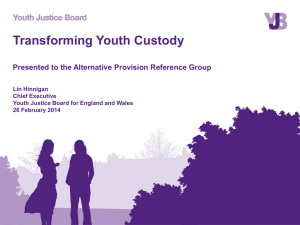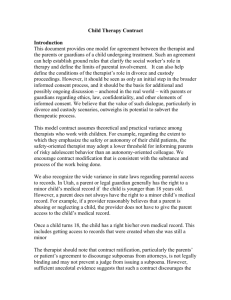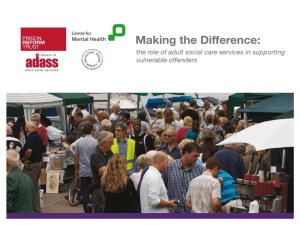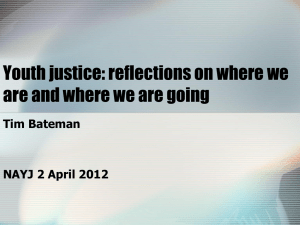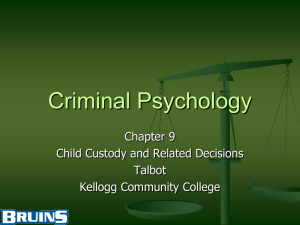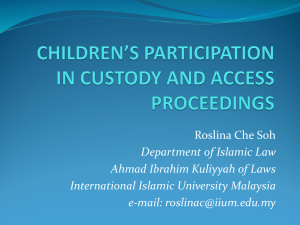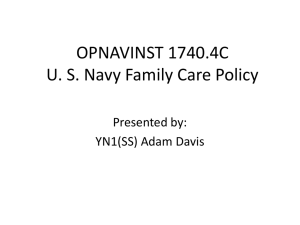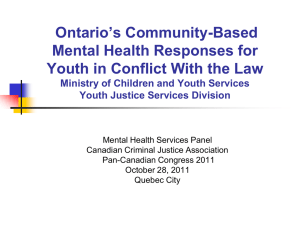T. Smith conference report
advertisement
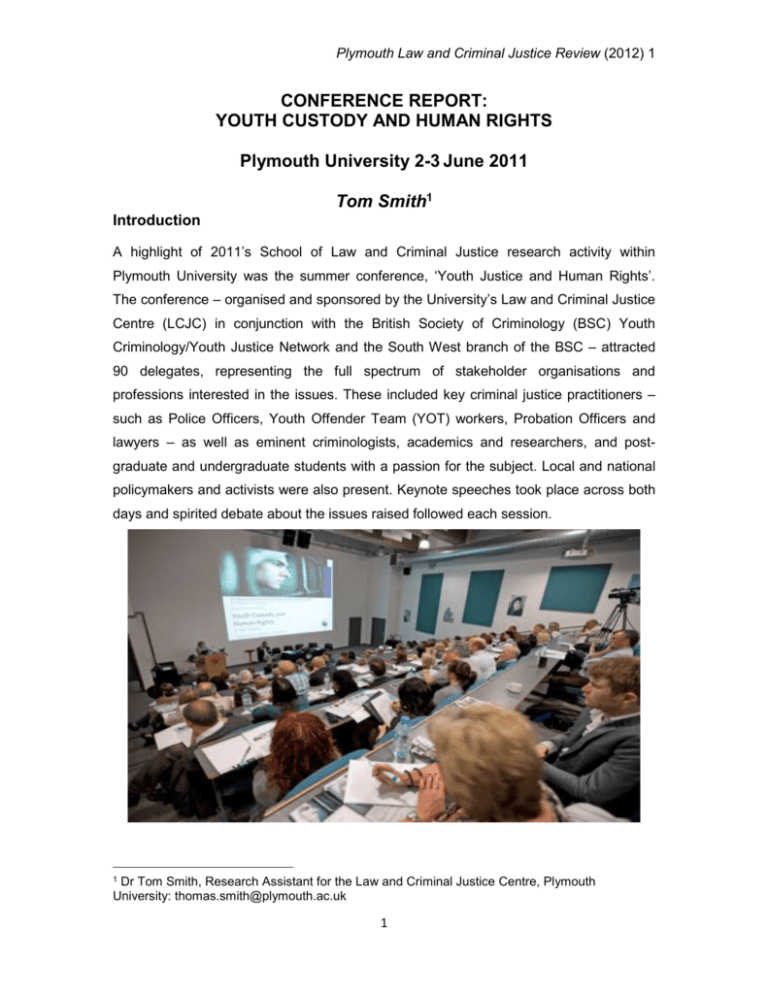
Plymouth Law and Criminal Justice Review (2012) 1 CONFERENCE REPORT: YOUTH CUSTODY AND HUMAN RIGHTS Plymouth University 2-3 June 2011 Tom Smith1 Introduction A highlight of 2011’s School of Law and Criminal Justice research activity within Plymouth University was the summer conference, ‘Youth Justice and Human Rights’. The conference – organised and sponsored by the University’s Law and Criminal Justice Centre (LCJC) in conjunction with the British Society of Criminology (BSC) Youth Criminology/Youth Justice Network and the South West branch of the BSC – attracted 90 delegates, representing the full spectrum of stakeholder organisations and professions interested in the issues. These included key criminal justice practitioners – such as Police Officers, Youth Offender Team (YOT) workers, Probation Officers and lawyers – as well as eminent criminologists, academics and researchers, and postgraduate and undergraduate students with a passion for the subject. Local and national policymakers and activists were also present. Keynote speeches took place across both days and spirited debate about the issues raised followed each session. 1 Dr Tom Smith, Research Assistant for the Law and Criminal Justice Centre, Plymouth University: thomas.smith@plymouth.ac.uk 1 Plymouth Law and Criminal Justice Review (2012) 1 1 Themes and Format Thematically, the conference took inspiration from the criticisms levelled at the UK by the Committee on the Rights of the Child (CRC) in 2008;2 as a signatory nation to the United Nations Convention on the Rights of the Child 1989 (UNCRC), the UK failed to uphold three of the standards contained – all relating to youth custody. These were as follows:3 A failure to uphold the principle that the ‘imprisonment of a child shall be used only as a measure of last resort and for the shortest appropriate period of time’ A failure to protect young people in custody from ‘inhumane and degrading treatment and punishment’, with particular reference to the use of physical restraint A failure to provide adequate resources for protecting the ‘best interests’ or welfare of young people leaving custody, damaging their chances of successful resettlement into community life. Using these criticisms as a structure, the conference was divided into three sessions over two days, Session One being ‘Youth Custody as a “Last Resort”’, Session Two being ‘Conditions Inside Custody’, and Session Three being ‘Resettlement and Social Exclusion’. Each session adopted the same format – four keynote speeches, followed by a panel discussion and ‘Question Time’ debate, during which conference delegates could contribute to the discussion. 2 Session One: Youth Custody as a ‘Last Resort’ Professor Simon Payne, Head of the School of Law and Criminal Justice, made the opening address, welcoming delegates to Plymouth University and the Conference. He lauded the inclusion of many key ‘societal actors’ in the conference, exemplifying the University’s ‘enterprising’ approach. He also described the issue of youth justice as a ‘timely and topical’ subject of debate, before briefly outlining the schedule for the conference. The first keynote speaker was Dr Tim Bateman, Reader in Youth Justice at the University of Bedfordshire. His address, entitled ‘Youth Imprisonment and the Punitive Turn’, dealt with three key issues; the dramatic rise in youth imprisonment in the 2 The Committee is a UN Treaty body, consisting of independent experts; it monitors whether the UNCRC has been implemented adequately. For more information, see http://www2.ohchr.org/english/bodies/crc/ 3 Committee on the Rights of the Child, ‘Consideration of Reports Submitted by State Parties under Article 44 of the Convention – Concluding Observations: United Kingdom of Great Britain and Northern Ireland’ (United Nations 2008). 2 Plymouth Law and Criminal Justice Review (2012) 1 1990s, whether the so-called ‘punitive turn’ is useful in explaining this, and how the recent reduction in youth imprisonment should be interpreted. Dr Bateman firstly explained the concept of the ‘punitive turn’ – that is, the inclination of the Conservative Government of the early to mid1990s towards tougher law and order. Arguably a result of moral panics (such as the Jamie Bulger murder), the thrust of this political ‘turn’ was higher institutional containment. New legislation, he argued, in the 1990s reflected this, although this was not the major catalyst for the rise in youth incarceration. He instead suggested that systematic changes – such as the rapid reduction of diversion from court, increased acceptance of custody by youth justice practitioners and more initiation of breach procedures, were of greater significance. Turning to the issue of the recent decline in numbers of imprisoned youths, Bateman argued that a decline in the politicization of youth justice (for example, the much maligned ASBO), financial considerations and the prioritization of reducing custody numbers may all have contributed. The second keynote speaker was Penelope Gibbs of the Prison Reform Trust, addressing the issue of ‘Drivers to and Reducing Youth Custody’. She opened by highlighting that the majority of youth imprisonment is a result of non-violent offences, raising the question of why imprisonment is employed despite the low levels of high risk of harm to others. She cited several factors as being key to explaining this phenomenon, including persistent offenders and the local customs and practices of some courts. She also suggested that the ‘big driver’ of risk-aversion contributed significantly, resulting in high levels of remand for youths – particularly youths suffering serious social disadvantage, such as parental bereavement, learning difficulties and familial criminality. Gibbs fielded questions from the audience, with one delegate asking whether it was better to risk a child re-offending or to imprison them. She responded by stating that prison tends to increase offending, and as such risking re-offending was better than increasing a youth’s likelihood of criminality by the use of custody. Carolyne Willow of the Children’s Rights Alliance for England delivered an impassioned address to the conference, entitled ‘Campaigning to Protect the Rights of Young People in Custody and Activating the UNCRC’. Discussing research into conditions in the Secure Estate for children – including institutions such as Secure Training Centres – she suggested that there was a degree of suppression of the human rights entitlements of 3 Plymouth Law and Criminal Justice Review (2012) 1 children in custody. Referring to Article 37(b) of the UNCRC (which states that the imprisonment of youths should be a ‘last resort’) she expressed concern at the large numbers of children in custody, particularly those who were deprived and came from a ‘damaging background’. She proceeded to highlight the large number of injuries sustained by children in custody when being restrained. As a result, significant numbers of staff within the Secure Estate had been disciplined, suspended or dismissed for incidents during restraint. On a positive note, Willow reported that through years of campaigning and legal challenges – and in the face of extreme resistance – guidance had now been issued for ‘methods of restraint’, helping to safeguard more children in custody. The final keynote speech of the first session was delivered by Adrian Quinn, the Service Manager of the Bristol Youth Offending Team. Tackling the issue of ‘Reducing Youth Custody in Practice’, he sought to outline what a Youth Offending Team (YOT) is and how it impacts on youth custody. Quinn started by outlining some important principles of sentencing relevant to youth custody – specifically that custody should be a last resort, that an offence must be so serious that community sentences and fines are not appropriate, and that the welfare of the offender must be considered. He highlighted that the YOT could influence the outcome for an offender at various stages, including in the custody suite (as an appropriate adult), when on bail, during compliance with a community order, in contributing to pre-sentence reports and in court. Finally, he talked about successful practices in YOT work. These included paying attention to practice at a local, strategic level, analysing failures in practice (for example, by conducting a ‘postmortem’ where things went wrong), encouraging positive bail packages, quality presentence reports and imaginative alternative sentences to custody for youths. Bringing Session 1 to a close, Dr Dan Gilling from the LCJC chaired a ‘Question Time’ debate, with all the keynote speakers. A delegate asked whether there was a correlation between the drop in youth crime and the rise in the use of custody. Views were mixed; whilst the panel accepted that one could make this argument, it was highlighted that previous statistical trends do not support this. For example, in the 1980s and early 2000s, there was a reduction in detected youth crime, but lower use of youth custody. It was suggested that reconviction rates undermine the argument that custody is effective and it was added that courts now have more faith in non-custodial sentences. 4 Plymouth Law and Criminal Justice Review (2012) 1 3 Session Two: Conditions Inside Custody The second session of the conference commenced with a keynote speech delivered by Professor Barry Goldson, the current Charles Booth Chair of Social Science at the University of Liverpool. His address, entitled ‘The Violence and Violations of Youth Imprisonment’, underlined the serious problem of violence against many of the thousands of children in custody in England and Wales. He stated that attention to this sort of violence had been fragmented and limited, despite the fact that children in conflict with the law are one of the most vulnerable groups in society. He identified several areas of concern, including the use of routine strip searches, the use of long-term segregation of offenders, and frequently used, adult methods of restraint and resultant injury. These issues represented a systematic violation of international human rights. Goldson made some suggestions for remedying this, including the strict application and enforcement of all conventions and treaties, a real drive to ingrain the ethos of youth custody to really being a ‘last resort’, and even the abolition of child custody altogether. The next speech was delivered by Her Majesty’s Chief Inspector of Prisons, Nick Hardwick, dealing with the issue of ‘Inspecting Standards in Young Offender Institutions’; this provided an insight into the workings of these institutions. He proceeded to outline the risks inherent in youth custody, such as the power imbalance and culture of dependence, the fact that many institutions are ‘closed’, the widespread acceptance of poor standards, and the problem of demoralised, under-paid, poorly-led staff. Hardwick then talked about how inspections are conducted. Highlighting that the UN requires regular, independent inspections he underlined that the inspectorate has the power to, without announcement, go where they want and see what they want at prisons, Young Offender Institutions (YOIs), and Police Custody, but not Secure Training Centres. In looking at treatment, conditions, and outcomes for inmates, he described how the inspectorate focuses on whether the institution is safe, an environment of respect, provides activities for inmates, and encourages resettlement. Unannounced, week-long inspections include both observation and surveys with random inmates. Summarising recent findings, Hardwick stated that most inmates felt reasonably respected, but many felt unsafe, that they were too far from home, were visited infrequently, had trouble resettling after release, and that too much restraint was used. 5 Plymouth Law and Criminal Justice Review (2012) 1 Professor Rod Morgan, Professor Emeritus at the University of Bristol and the former Chairman of the Youth Justice Board, delivered the next address which was entitled ‘Limiting the Use of Custody’. He started by discussing the Coalition Government’s ‘Big Society’ initiative – underpinned by ideas such as localisation of power and funding, cutting ‘red-tape’, encouraging diversity between sectors, more voluntary work, and the involvement of communities. However, Morgan suggested these were a ‘fig leaf’ for cuts and privatisation in criminal justice and other areas that were already underway. Considering the previous government, he described the policy of ‘governing through crime’ – involving more police, more police powers and longer sentences, with little direct effect on youth crime. However, between 2009 and 2011, he described how a 30% decline in youth custody could be partly attributed to the abandonment of ‘offences brought to justice’ targets, an increase in ‘common sense’ policing and a culture of decriminalising children. He continued by stating that research suggests criminalisation increases the likelihood of criminal activity, and as such custody should be used less, allowing social order issues to be tackled in more effective ways. He concluded by highlighting positives about the youth justice system at present, including Youth Justice Pathfinders, the cost of custody passing to Local Authorities, and increased pressure for parsimonious policing. The final keynote speech of Session Two was delivered by Dr Ursula Kilkelly, of the University College Cork. Tackling the subject, ‘International Standards: Maximising Potential’, she described the variety of international standards relating to child protection and youth custody. She outlined their core principles, including detention as a ‘last resort’, the separation of children from adults, the treatment of children with dignity, in a manner appropriate to their age, and aimed at reintegration into society. She proceeded to describe how these standards, in accordance with the rule of law and professional accountability, uphold rights to challenge the lawfulness of such detention, secure an independent complaints procedure, monitor and inspect custody, acquire information, and set policy and procedure to protect rights. She underlined the value of the myriad standards, asserting that they were detailed, legally binding, drawn from a range of sources, representative of consensus, reflective of best practice, inter-disciplinary, and applicable at international, domestic and local levels. She then asserted that more research is required in this area, aimed at analysing the standards and their application, assessing their use in teaching the ‘next generation’ of lawyers, examining compliance 6 Plymouth Law and Criminal Justice Review (2012) 1 with the standards, and promoting dialogue about the standards. She concluded that the standards were valuable but only a beginning, and that cross-disciplinary partnerships, involving practitioners, youths, law and policy makers, civil society and academia, could help identify what is working and why. Again, the session concluded with a ‘Question Time’ debate, chaired by Dr Jill Annison of the LCJC. One delegate questioned whether 10 years old was an appropriate age at which to set criminal responsibility; the panel unanimously agreed that it was not appropriate, that it was a poor indicator of culpability, that it did not reflect a child’s capacity to be responsible for criminal actions, that it was a political decision in conflict with international standards, and that it should be raised. Another delegate suggested to the panel that in practice there had been a shift away from actively working with young people towards a continual monitoring and auditing process. The panel had mixed views about this; some empathised with the frustration of the delegate, but responded that inspecting the outcomes for inmates was critical and that it was an effective way of measuring standards. In contrast, the panel also expressed disappointment in the reduced ‘face time’ with children, stating that relationship building was a key ingredient. 4 Session Three: Resettlement and Social Exclusion The conference closed with a third session focused on post-custody resettlement of youths and the associated problems of social exclusion. Professor John Pitts, of the University of Bedfordshire, delivered the first keynote speech, entitled ‘”Deadly Symbiosis”: The Gang, the Neighbourhood and the Secure Estate’. He commenced by stating that resettlement should form part of effective offender management, involving a seamless sentence, management of risk, directly addressing offending behaviour and social reintegration. However, he underlined the potential risks posed to this by returning prisoners who were in gangs prior to custody. These were usually more serious offenders, with a variety of difficulties including a lack of education and limited family contact. Gang members were often the least effected by the ‘best of the penal system’ with most returning to the poor, gang-affected urban postcodes primarily covered by prisons, and thus returning to their gang and to offending. Pitts described a ‘deadly symbiosis’: ‘the ghettoization of prison, and the prisonization of the ghetto’, where the cultures of the two merge. Returning gang youths re-enter a brutal world which weakens family ties, reinforces deviance, breeds anger and resentment at the perceived injustice of imprisonment and consolidates a self-perception as a ‘gangster’ with a ‘soldier 7 Plymouth Law and Criminal Justice Review (2012) 1 mentality’. Conversely, the gang provides protection, inclusion, power, status and respect. Pitts suggested strategies for changing this, citing family support, YOTs and local youth justice plans as being central. Professor Kathryn Hollingsworth of Newcastle University delivered the second address of the third session, discussing ‘Using the Law to Protect the Resettlement Rights of Young People Leaving Custody’. She began by highlighting that, notwithstanding being mentioned in both Article 40 of the UNCRC and the Havana Rules, there is no specific ‘right’ to resettlement. The rights referred to were socio-economic rights – rights that cannot be defended easily in the courts of England and Wales. She pinpointed domestic provisions for these rights, including ‘soft law’ such as guidance and codes, but expressed concern about the shortcomings in approaching resettlement. There were flaws in delivering smooth resettlement, with too much focus on re-offending rather than needs, conflicting obligations for YOT workers, time limitations, and the deprioritization of resettlement generally. Hollingsworth also criticised the legal basis for protecting these rights, with no primary legislation, a lack of enforceability and inconsistent monitoring of compliance. However, she suggested that the creation of statutory rights of resettlement for youths after custody could resolve these issues. She argued that the creation of a specific statutory provision for disadvantaged children would help establish consistent and universal support for post-custody youths, create legally binding and enforceable rights, and represent a symbolic acceptance of the needs of post-custody youths. Chris Callendar of the Howard League made the penultimate keynote speech of the conference, entitled ‘The Resettlement Needs of Young People Leaving Custody: Difficulties and Dilemmas’. He opened by remarking that children in custody have almost always suffered from issues including abuse, neglect, familial separation, lack of education, unemployment, homelessness, mental health issues, or problems with drugs and alcohol. He suggested that dealing with the risk of re-offending requires us to deal with the welfare of such children, and that an enforceable legal mechanism is required to ensure local authorities provide for custody leavers. Callendar referenced the Children Act 1989 and a variety of statutory guidance on this issue. He stated that local authorities are obliged to undertake a formal, documented assessment of a child’s needs under the statute, as well as provide suitable accommodation. In summary, he stated that resettlement legislation was good but poorly implemented and not understood. He proceeded to assert that the criminal justice system exists because of the failures of the 8 Plymouth Law and Criminal Justice Review (2012) 1 state to provide for its citizens adequately; since welfare is cheaper, more humane and more effective, he suggested that this should form the focus for ensuring better resettlement of child custody leavers. The final speech of the conference was delivered by the current Director of Strategy at the Youth Justice Board, Bob Ashford. He opened his address, entitled ‘Effective Resettlement in a Changing Youth Justice Landscape’, by reporting that first time entrants into the criminal justice system had dropped and that unverified data suggested reoffending by young people had dropped over the last nine years; he added that in the last two years, use of custody had been scaled back and many secure estate establishments had been decommissioned. Discussing the future of the youth justice system, he pointed to the ‘big changes’ heralded by the Justice Green Paper published in 2010. The inclusion of ‘financial incentive models’ and ‘payment by results’ schemes appear to be aimed at convincing local authorities and other agencies to engage with youths in custody. Ashford referred to Youth Justice Board pathfinders as an example, incentivising reductions in custody use with increased funding. In terms of resettlement, he noted that the Green Paper recognises it as critical to reducing reoffending and that money had been ‘ring-fenced’ to support integrated resettlement. He suggested that the involvement of regional resettlement consortia should be developed, since many custody leavers are moved around from one local authority to another. He concluded by citing the potential deprioritization of resettlement, rising youth unemployment, insufficient incentives and public perception as risks and barriers to effective resettlement. The conference was drawn to a close with a final ‘Question Time’ debate, chaired by Conference Organiser Dr Patricia Gray. A delegate asked how practitioners, lawyers, academics, policy makers and researchers can help develop a systematic approach to protecting the resettlement rights of youths in the criminal justice system. The panel offered various thoughts. It was suggested that an independent advocacy service should be established to aid youths in custody and that a review of the care system was desperately needed. Furthermore, it was suggested that youths in custody should be brought into the ‘looked after’ state (i.e. alongside children in care). This debate concluded what can be regarded as a highly successful and varied Conference on Youth Justice and Human Rights. 9 Plymouth Law and Criminal Justice Review (2012) 1 Conclusion The Plymouth Law and Criminal Justice Review would like to extend its congratulations to everyone involved in arranging the conference, in particular to Patricia Gray, who spearheaded the organisation of this excellent academic event. The Conference organisers are currently considering publishing a book based on the conference proceedings, with several publishers showing an interest. In bringing together academics, policy makers, practitioners and human rights activists, a key aspiration of the conference was that it would lead to better protection of the rights of young people subject to custodial sentences through an appeal to the 1989 United Nations Convention on the Rights of the Child. 10

